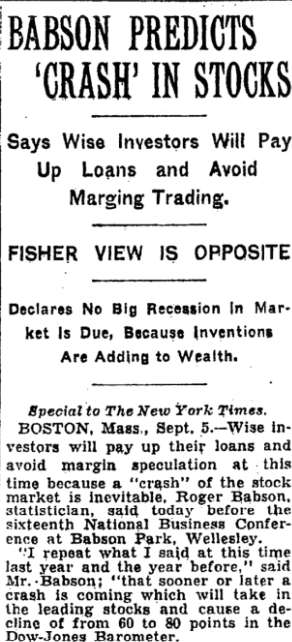Many investors know what happened in October 1929, even if they don’t realize it. That was when stocks crashed and triggered the Great Depression.
On October 28, 1929, the Dow Jones Industrial Average fell 12.8%. It lost another 11.7% the next day. At the close on October 29, the Dow was more than 40% below its September 3 high.
Investors were shocked. But The New York Times warned of a crash on September 6. A statistician named Roger Babson said that “sooner or later a crash is coming…” He expected a decline of at least 16%.

Source: The New York Times.
Of course, many disagreed with Babson. Among them was Irving Fisher, a noted Harvard economist and stock market expert. Fisher argued that stock prices were justifiably high because corporate earnings were rising, and investors were diversifying because of innovations in the market like unit trusts (similar to mutual funds).
Babson was right. He continued offering sound advice into the 1960s, when he was beyond 80 years old.
In 1935, he recommended an income investment. He was talking about a specific one many don’t know about today…
A Hybrid of Stocks and Bonds
Babson wrote: “It is sometimes said that preferred stocks provide more liberal yields than bonds and a greater certainty of income than common stocks.”
Now almost 90 years later, Babson’s words are still true.
Preferred stocks are a hybrid investment. They have some of the characteristics of stocks. Most importantly, they trade like stocks. They also share some characteristics with bonds. Most importantly, they pay a steady income.
Many banks issue preferred stocks. The specific reasons are technical, but they generally do this to meet regulatory requirements related to capital ratios. Preferreds pay a quarterly dividend that is fixed when the shares are issued.
Some preferreds can be converted to common stock. This offers some of the upside of common stocks. But the dividend is almost guaranteed unless the issuer goes bankrupt. If the issuer skips a payment, they often have to pay all arrears before they can pay dividends on their common stock.
In the long run, preferreds should deliver returns that are between stocks and bonds.
Despite their benefits, many investors don’t hold preferred stock in their portfolios. One reason is because a lot of information about preferreds isn’t readily available. There isn’t a benchmark index. Information about the securities can be difficult to find. But with some effort, this information can be obtained.
Income investors can get better returns from preferreds than common stocks in banks of all sizes. Here’s how preferred yields play out for some of the most recognizable names.
Preferred Yield vs. Dividend Yield of Bank Stocks
| Preferred yield | Dividend yield | |
| JPMorgan (JPM) | 5.6% | 2.7% |
| Bank of America (BAC) | 6.0% | 3.4% |
| Wells Fargo (WFC) | 6.5% | 3.4% |
| Morgan Stanley (MS) | 6.5% | 4.1% |
But if the research is too daunting, there is an exchange-traded fund (ETF) that offers exposure to preferred stocks. It’s called iShares Preferred and Income Securities ETF (Nasdaq: PFF) and offers a 6.8% yield.
Now is an ideal time to look at preferreds. Like bonds, they decline in value when interest rates rise. This means PFF is more than 20% below the price it was at when the Federal Reserve began raising rates. Rate hikes may be ending, and future cuts will lead to higher prices in preferreds.
Preferred stocks are a source of Endless Income. While most have heard of 401(k)s, IRAs and Roth IRAs, there are dozens of other tools, tactics and income investments that most Main Street retirees don’t even know exist.
Secrets that the wealthy have been using to boost their money for years.
You can learn more about these unexpected investments in a brand-new book, Endless Income: 50 Secrets for a Happier, Richer Life.
Click here to find out how to obtain a copy today.
Until next time,

Mike Carr
Senior Technical Analyst





